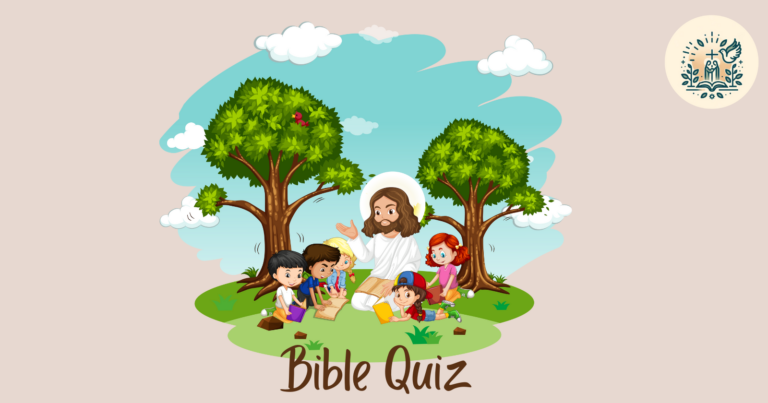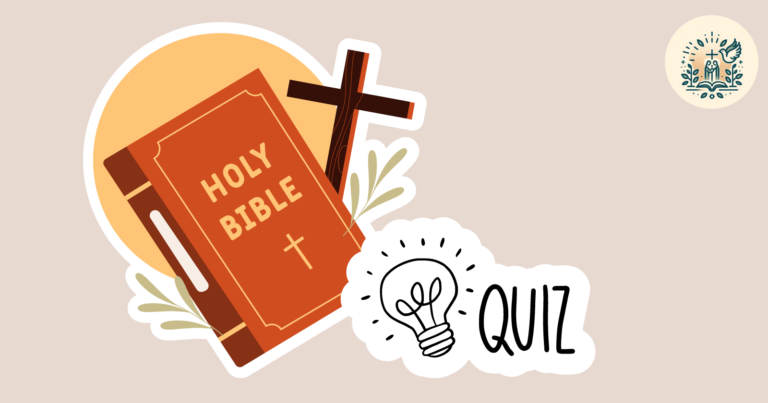Congratulations on embarking on a reflective journey through our Easter-themed quiz!
We asked some tough questions about the Bible, focusing on Easter and beyond.
If you’re curious about the right answers and why they matter, you’re in the right place.
Here, not only will you find the answers to each question, but we’ll also share insights and explanations that illuminate the deeper meanings and connections within your faith
Let’s find out what you’ve learned and maybe pick up some new facts along the way.
6 easy Bible questions for beginners
- Who built the ark?
Answer: B. Noah
- Noah built the ark as instructed by God to save his family and pairs of every animal species from the flood.
- Which book comes first in the New Testament?
- Answer: C. Matthew
- The Book of Matthew is the first book in the New Testament, presenting the life and teachings of Jesus.
- Answer: C. Matthew
- What fruit did Adam and Eve eat from the forbidden tree?
- Answer: D. The Bible doesn’t specify
- The Bible does not specify the type of fruit. Although it’s commonly depicted as an apple in art and literature for symbolic purposes, the reality is that the Bible doesn’t mention anything about the apple.
- Answer: D. The Bible doesn’t specify
- How many days did God take to create the world?
- Answer: A. 6 days
- According to Genesis, God created the world in six days and rested on the seventh.
- Answer: A. 6 days
- Who did God give the Ten Commandments to?
- Answer: A. Moses
- God gave the Ten Commandments to Moses on Mount Sinai to guide the moral and spiritual conduct of the Israelites.
- Answer: A. Moses
- Where was Jesus born?
- Answer: C. Bethlehem
- Jesus was born in Bethlehem, fulfilling the prophecy about the Messiah’s birthplace.
- Answer: C. Bethlehem
3 questions on Easter symbols and traditions
- Why is the lamb a prominent symbol in Easter celebrations, and what does it represent?
- Answer: C. Jesus Christ, as the “Lamb of God.”
- The lamb represents Jesus Christ, symbolizing his sacrifice as the “Lamb of God” for the sins of humanity.
- Answer: C. Jesus Christ, as the “Lamb of God.”
- What do Easter eggs symbolize, and how did the tradition of decorating them come about?
- Answer: C. The resurrection of Jesus, with early Christians of Mesopotamia dyeing them red.
- Easter eggs symbolize new life and the resurrection of Jesus. The tradition of decorating eggs dates back to early Christians, who dyed them red to represent the blood of Christ.
- Answer: C. The resurrection of Jesus, with early Christians of Mesopotamia dyeing them red.
- The Easter Lily is often associated with the resurrection. What does it signify, and why is it linked to Easter?
- Answer: D. Purity, hope, and renewal, with its white color symbolizing light and purity.
- The Easter Lily represents purity, hope, and renewal, while its white color symbolizes the purity of Jesus and the resurrection’s promise of new life.
- Answer: D. Purity, hope, and renewal, with its white color symbolizing light and purity.
4 questions on the life and teachings of Jesus
- During Jesus’ trial, which figure famously asked Him, “What is truth?”
- Answer: B. Pontius Pilate
- Pontius Pilate, the Roman governor, questioned Jesus about truth during his trial, illustrating the philosophical dilemma of discerning ultimate truth.
- Answer: B. Pontius Pilate
- Reflect on Jesus’ prayer in the Garden of Gethsemane. How does this moment illustrate His humanity and submission to God’s will?
- Answer: C. Jesus asks if the cup (His suffering) can be taken from Him, yet he submits to God’s will.
- This moment highlights Jesus’ humanity in facing suffering and his submission to God’s will, embodying obedience and faith.
- Answer: C. Jesus asks if the cup (His suffering) can be taken from Him, yet he submits to God’s will.
- In Jesus’ parable of the Sower, what does the seed falling on the rocky ground represent?
- Answer: C. Those who hear the word but fall away when troubles come
- The seed on the rocky ground symbolizes those who initially receive the message with joy but fall away when faced with trials or persecution.
- Answer: C. Those who hear the word but fall away when troubles come
- Which of the following miracles is attributed only to Jesus in all four Gospels?
- Answer: C. Feeding the 5,000
- The feeding of the 5,000 is the only miracle of Jesus documented in all four Gospels, emphasizing its importance and the message of divine provision.
- Answer: C. Feeding the 5,000
5 questions about key events in the New Testament
- Which event marks the beginning of Jesus’ public ministry?
- Answer: A. His baptism by John the Baptist
- Jesus’ baptism marks the commencement of His public ministry, signifying His readiness to fulfill His messianic mission.
- Answer: A. His baptism by John the Baptist
- The Transfiguration of Jesus is a moment of divine revelation. Who appeared alongside Jesus?
- Answer: A. Moses and Elijah
- Moses and Elijah appeared during the Transfiguration, representing the Law and the Prophets and affirming Jesus as the fulfillment of both.
- Answer: A. Moses and Elijah
- In Acts, the Holy Spirit descends upon the Apostles during Pentecost. What unique ability were they granted?
- Answer: B. The ability to speak in different tongues (languages)
- The Apostles were granted the ability to speak in various languages, symbolizing the universal reach of the Gospel and the birth of the Church.
- Answer: B. The ability to speak in different tongues (languages)
- Paul’s conversion on the road to Damascus is a cornerstone event. What was Paul’s mission at the time?
- Answer: C. To persecute Christians
- At the time of his divine encounter, Paul was on a mission to persecute Christians, highlighting the transformative power of God’s grace.
- Answer: C. To persecute Christians
- The Council of Jerusalem addressed a pivotal question in early Christianity. What was the main issue?
- Answer: B. The necessity of circumcision for Gentile converts
- The council debated whether Gentile converts needed to follow Jewish customs like circumcision, emphasizing the inclusivity of the Gospel.
- Answer: B. The necessity of circumcision for Gentile converts
5 questions on prophets and prophecies
- Who is the prophet known for his confrontation with the prophets of Baal?
- Answer: B. Elijah
- Elijah confronted the prophets of Baal on Mount Carmel, showcasing the power of God over false idols.
- Answer: B. Elijah
- Which prophet interpreted dreams for a king and had visions of the end times?
- Answer: A. Daniel
- Daniel served in the Babylonian and Persian courts, interpreting dreams and receiving visions that included prophecies of future kingdoms and the end times.
- “For unto us a child is born, unto us a son is given…” is attributed to which prophet?
- Answer: B. Isaiah
- This prophecy by Isaiah is one of the clearest Old Testament indications of the coming of Jesus Christ and His divine mission.
- Ezekiel’s vision of dry bones coming to life is symbolic of what?
- Answer: B. The restoration of Israel after exile
- Ezekiel’s vision symbolizes the hope of national restoration for Israel, promising revival and reunification for God’s people.
- “My God, my God, why have you forsaken me?” fulfills a prophecy from which Old Testament book?
- Answer: B. Psalms
- This cry from Jesus on the cross echoes Psalm 22, illustrating the depth of His suffering and the fulfillment of Messianic prophecy.
4 questions on parables and miracles
- Which parable teaches the importance of being prepared?
- Answer: D. The Parable of the Ten Virgins
- This parable emphasizes vigilance and preparedness for the Kingdom of Heaven, symbolized by the wise virgins who kept their lamps lit.
- Jesus performed his first miracle at a wedding in Cana. What did he turn into wine?
- Answer: A. Water
- This miracle of turning water into wine at the wedding feast signifies Jesus’ divine authority and the joy of God’s kingdom.
- In the Parable of the Good Samaritan, who is NOT one of the characters?
- Answer: C. A merchant
- The parable features a priest, a Levite, and a Samaritan to teach about love and compassion beyond societal boundaries.
- Which miracle involves Jesus feeding a multitude?
- Answer: B. Feeding of the 5000
- This is the only miracle recorded in all four Gospels, highlighting its importance in demonstrating Jesus’ compassion and divine provision.
3 questions on apostles and early Christians
- Who was the apostle known as the “rock” upon which Jesus said He would build His church?
- Answer: C. Peter
- Peter’s role as the foundational “rock” symbolizes the establishment of the church and his leadership among the apostles.
- Which apostle is credited with writing the majority of the New Testament letters?
- Answer: D. Paul
- Paul’s epistles to the early Christian communities form a significant portion of the New Testament, addressing theology, ethics, and church organization.
- The Council of Jerusalem decided that Gentile converts to Christianity did not need to follow what Jewish custom?
- Answer: C. Circumcision
- This landmark decision marked a turning point in early Christianity, emphasizing faith in Jesus Christ over adherence to Jewish law for salvation.
Wrapping up the Easter quiz
I hope you found these questions enlightening and the answers provided you with deeper insights into your faith and the biblical narrative.
Remember, this is just one of many journeys we’ll embark on together.
Every week, we’ll bring new quizzes to challenge your knowledge, stir your curiosity, and perhaps even deepen your faith. It’s an ongoing opportunity to explore the vast landscapes of our beliefs, to question, to learn, and to grow.
So, stay tuned, and let’s continue this beautiful journey of discovery together.











